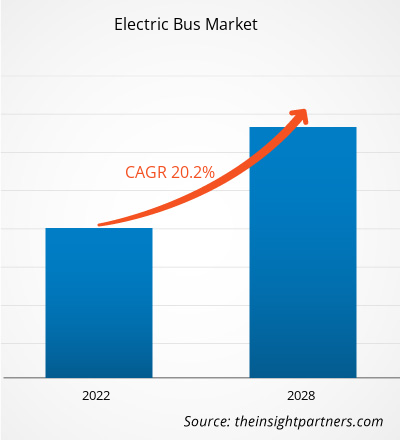[調査レポート] 電気バス市場は2021年に291億7,951万米ドルと評価され、2028年までに1,058億815万米ドルに達すると見込まれています。また、2021年から2028年にかけて20.2%のCAGRを記録すると推定されています。
アナリストの視点:
近年、電気バス市場は大きな成長と変革を経験しています。環境の持続可能性への関心の高まりと炭素排出量の削減の必要性から、電気バスは公共交通機関の有望なソリューションとして浮上しています。電気バスは従来の化石燃料の代わりに電気で駆動され、排気ガスゼロ、騒音公害の低減、エネルギー効率の向上など、多くの利点があります。これらの要因により、世界中で電気バスの採用が促進されています。多くの国の政府や交通機関は、持続可能な交通イニシアチブの一環として、電気バスの導入を積極的に推進しています。中国政府は、電気バスの導入を促進し、より環境に優しい公共交通機関への移行を加速させるため、様々な優遇措置、補助金、規制を導入しています。電気バス分野の主要企業は、バッテリー技術の向上、充電インフラの改善、そして電気バスの航続距離と効率の向上を目指し、研究開発に多額の投資を行ってきました。その結果、電気バスの性能と信頼性は時間とともに大幅に向上し、従来のバスに代わる現実的な選択肢となっています。
中国は電気バス最大の市場として台頭し、世界の販売台数の大きなシェアを占めています。中国政府の強力な支援と優遇政策、そして同国が掲げる環境汚染削減に向けた意欲的な目標が、中国の電気バス市場の急速な成長を後押ししています。しかし、電気バスは中国だけにとどまりません。米国、欧州諸国、インドなど、他の多くの国でも電気バスの導入が急増しています。欧州では、オランダ、ドイツ、英国などの国々が、厳格な排出規制と持続可能な交通目標を背景に、電気バス導入の最前線に立っています。電気バス市場も、自動運転電気バスの開発など、技術革新の波に乗っています。これらの自動運転バスは、効率的で便利なモビリティソリューションを提供することで、公共交通機関に革命をもたらす可能性を秘めています。
市場概要:
従来の内燃機関(ICE)を動力源としない、完全に電気で動くバスは、電気バスまたはeバスと呼ばれます。eバスは、バッテリーセットまたはオンボードバッテリーが搭載する電動モーターで駆動します。汚染物質を排出せず、従来のガソリン/ディーゼルバスよりもコスト効率が高いため、電気バスは環境に優しいバスとして認識されています。
要件に合わせてレポートをカスタマイズ
レポートの一部、国レベルの分析、Excelデータパックなどを含め、スタートアップ&大学向けに特別オファーや割引もご利用いただけます(無償)
電気バス市場: 戦略的洞察

- このレポートの主要な市場動向を入手してください。この無料サンプルには、市場動向から見積もりや予測に至るまでのデータ分析が含まれます。
市場の牽引力:様々な都市や地域での電気バスの導入成功が電気バス市場の成長を牽引
レポートの一部、国レベルの分析、Excelデータパックなどを含め、スタートアップ&大学向けに特別オファーや割引もご利用いただけます(無償)
電気バス市場: 戦略的洞察

- このレポートの主要な市場動向を入手してください。この無料サンプルには、市場動向から見積もりや予測に至るまでのデータ分析が含まれます。
様々な都市や地域での電気バスの導入成功は、電気バス市場の発展を牽引する上で重要な役割を果たします。都市や交通機関が電気バス車両群の導入に成功し、その有効性を実証すると、市場に様々な形でプラスの影響が波及します。まず、導入成功は概念実証となり、電気バスの実現可能性とメリットを他の都市や地域に示すことができます。ある都市が電気バス導入による良好な結果を示すと、他の都市も追随する意欲が湧きます。交通機関や自治体は、電気バスの運行実績、環境への影響、そして一般市民の反応を観察し、持続可能な交通手段の可能性に対する信頼を高めます。
次に、導入成功はドミノ効果を生み出し、都市や地域間の競争意識を育みます。近隣の都市や地域で電気バスが導入され、良好な結果が得られると、近隣の自治体も競争力維持のために導入を検討するようになります。これにより健全な市場競争が生まれ、より多くの都市がよりクリーンで環境に優しい公共交通機関への移行に加わるにつれて、電気バス市場の成長が促進されます。さらに、導入の成功は学習の機会となります。都市や交通機関は、先行導入者の経験から、ベストプラクティス、直面した課題、障壁を克服するための戦略などを学ぶことができます。こうした知識共有により、その後の導入においてよりスムーズかつ効率的な導入が可能になり、電気バス市場全体の成長が加速します。導入の成功はメディアの注目や一般の関心を集め、電気バスに対する好意的な宣伝効果も生み出します。電気バスによって環境面でのマイルストーンを達成し、大気質を改善した都市のメディア報道は、一般の人々の意識を高めます。これは、電気バスが従来のバスに代わる現実的で持続可能な代替手段であるという認識を後押しします。こうした認知度の向上は市場心理の好転につながり、より多くの都市、交通機関、そして関係者が電気バスを採用するよう促します。これにより、電気バスはより手頃な価格になり、より幅広い都市や地域にとって魅力的なものとなり、市場の成長を促進します。
セグメント分析:
車両タイプに基づいて、市場はバッテリー電気バス、ハイブリッド電気バス、プラグインハイブリッド電気バスに分類されます。バッテリー電気バスセグメントは2020年に最大の市場シェアを占め、予測期間中に市場で最も高いCAGRを記録すると予想されています。バッテリー電気バスは電気バス市場の主要な技術となり、最大の市場シェアを獲得しています。これは主に、排気ガスを排出しないという環境持続可能性によるもので、世界的な炭素排出量削減の取り組みと一致しています。エネルギー密度の向上や航続距離の延長など、バッテリー技術の進歩により、バッテリー電気バスの性能と実現可能性が向上しています。充電インフラネットワークの拡大も、その実用性をさらに支えています。政府の好ましい政策とインセンティブ、そして大手バスメーカーの積極的な関与が、バッテリー電気バスの普及に貢献しています。これらの要因が市場の成長を牽引しているため、バッテリー式電気バスは業界で主導的な地位を維持すると予想されています。
地域分析:
アジア太平洋地域の電気バス市場は、2021年に263億7,534万米ドルと評価され、2028年までに153億8,611万米ドルに達すると予測されています。予測期間中、年平均成長率(CAGR)20.2%で成長すると見込まれています。アジア太平洋地域は、電気バスの主要市場として登場し、著しい成長を示し、かなりの市場シェアを獲得しています。この地域での優位性に貢献している主な要因はいくつかあります。まず、アジア太平洋地域、特に中国は、電気バスの導入で最前線に立っています。中国は、大気汚染に対処し、温室効果ガスの排出を削減するための野心的な政策と目標を実施しています。
中国政府は、電気バスの導入を加速するために、補助金や助成金などの強力なサポートとインセンティブを提供してきました。この積極的なアプローチにより、中国は世界最大の電気バス市場となり、アジア太平洋地域における優位性を牽引しています。さらに、アジア太平洋地域は人口が多く、都市部が多いことから、持続可能で効率的な公共交通機関ソリューションが切実に求められています。急速な都市化と大気汚染や交通渋滞への懸念の高まりを受け、インド、日本、韓国などの政府や交通機関は電気バスの導入を優先しています。人口密度の高い都市環境と交通量の増加により、電気バスは排出量の削減と大気質の改善において魅力的な選択肢となっています。
さらに、アジア太平洋地域における強固な製造エコシステムも、その優位性に重要な役割を果たしています。アジア諸国、特に中国は、バスを含む電気自動車の製造において、強力な製造インフラと専門知識を有しています。現地メーカーは研究開発に多額の投資を行い、バッテリー技術と費用対効果の高い生産方法の進歩を推進してきました。これにより、競争の激しい市場環境が生まれ、様々な価格帯で幅広い電気バスモデルが提供されるようになり、市場優位性をさらに高めています。さらに、政府の支援政策や取り組みが、アジア太平洋地域の電気バス市場の発展を加速させています。政府は、電気バスの導入を促進するために、規制、排出基準、財政的インセンティブを導入しています。これらの政策は好ましいビジネス環境を作り出し、交通機関が電気バス車両に投資する推進力となっています。
主要プレーヤーの分析:
電気バス市場の分析には、King Long United Automotive Industry Co. Ltd、AB Volvo、Shenzhen Wuzhoulong Motors Co., Ltd、BYD Company Limited、Daimler、AGAlexander Dennis Limited、EBUSCO、Proterra Solaris Bus & Coach SA、NFI Group Inc.などのプレーヤーが含まれています。電気バスのプレーヤーの中で、AB VolvoとEBUSCOは、提供される多様な製品ポートフォリオにより、トップ2のプレーヤーとなっています。
電気バス市場の地域別分析
予測期間を通じて電気バス市場に影響を与える地域的な動向と要因については、The Insight Partnersのアナリストが詳細に解説しています。このセクションでは、北米、ヨーロッパ、アジア太平洋、中東・アフリカ、中南米における電気バス市場のセグメントと地域についても解説しています。
電気バス市場レポートの範囲
| レポート属性 | 詳細 |
|---|---|
| の市場規模 2021 | US$ 29.18 Billion |
| 市場規模別 2028 | US$ 105.81 Billion |
| 世界的なCAGR (2021 - 2028) | 20.2% |
| 過去データ | 2019-2020 |
| 予測期間 | 2022-2028 |
| 対象セグメント |
By 車両タイプ
|
| 対象地域と国 | 北米
|
| 市場リーダーと主要企業の概要 |
|
電気バス市場のプレーヤー密度:ビジネスダイナミクスへの影響を理解する
電気バス市場は、消費者の嗜好の変化、技術の進歩、製品の利点に対する認知度の高まりといった要因により、エンドユーザーの需要が高まり、急速に成長しています。需要が高まるにつれ、企業は製品ラインナップの拡充、消費者ニーズへの対応、そして新たなトレンドの活用を進めており、これが市場の成長をさらに加速させています。

- 入手 電気バス市場 主要プレーヤーの概要
電気バス市場では、合併や買収などの無機的および有機的な戦略が企業に広く採用されています。最近の主要な市場動向をいくつか以下に示します。
- 2022年3月:Proterra Incは、Blue Arc専用電動配達バンとEVシャーシに電力を供給するため、Shyft Groupとの戦略的複数年供給契約を発表しました。
- 2020年7月、AB Volvoは西オーストラリア州公共交通局(PTA)と提携し、ボルボ初の電気バスをオーストラリアに導入しました。これらの規定は、ボルボのオーストラリア製品ラインで技術が利用可能になったときに、代替動力車両を公共交通バスネットワークに導入するためのものです。
- 過去2年間の分析、基準年、CAGRによる予測(7年間)
- PEST分析とSWOT分析
- 市場規模価値/数量 - 世界、地域、国
- 業界と競争環境
- Excel データセット
最新レポート
お客様の声
購入理由
- 情報に基づいた意思決定
- 市場動向の理解
- 競合分析
- 顧客インサイト
- 市場予測
- リスク軽減
- 戦略計画
- 投資の正当性
- 新興市場の特定
- マーケティング戦略の強化
- 業務効率の向上
- 規制動向への対応




















 無料サンプルを入手 - 電気バス市場
無料サンプルを入手 - 電気バス市場